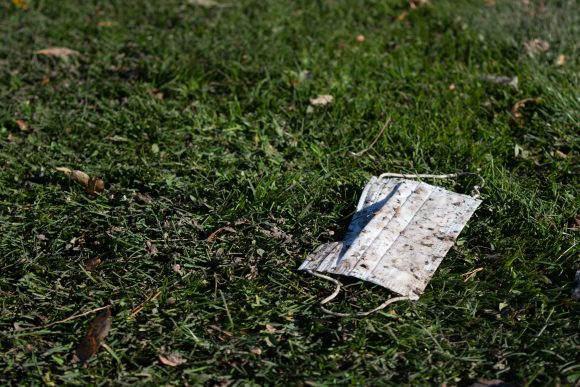
Discarded face masks line the paths at CU Boulder. October 30, 2020 (Marion Walmer / CU Independent)
If the thought of using plastic utensils and paper serveware in every restaurant you have been to since COVID-19 worries you, then you’re not alone. The pandemic may have provided environmental benefits such as less air and noise pollution during the first months that the U.S. was on lockdown, but now, with the recent increase in single-use materials, sustainable consumption is under threat across the country. Practicing sustainability and sanitization is not easy. In fact, it would be foolish to expect a student living on campus to be able to reduce their waste entirely this semester.
At the onset of COVID-19, mass panic buying of perishable food generated metric tons of waste. Additionally, the use of plastic materials, such as plastic bags, also increased.
According to the University of Colorado Boulder’s Zero Waste Program Manager Daniel Baril, the university did not know what to expect in terms of managing on-campus waste. The Environmental Center on campus developed a “Zero Waste While We Shelter in Place” webpage with tips for students to reduce single-use materials. It also offers strategies on how to throw out waste properly. However, there are still concerns about whether or not students take the time to dispose of waste correctly.
“I do not think students always throw out their trash correctly. I know many of my friends don’t even recycle at home and I think that’s the biggest problem,” CU Boulder sophomore Emma Curtis said, “But it does seem that on campus and in stores, where there are specific containers for recyclables, compostables and landfill, people really do throw… their trash out correctly.”
CU Boulder’s plan for waste management during COVID-19 was loose from the start.
“I was definitely concerned,” Baril said. “The dining waste was a bit of a wild-card. We didn’t really know what was going to happen.”
Baril and the rest of the Environmental Center provided more composting stations near residence halls and urged students to read the labels on trash bins to know where specific items can be disposed of to work with their uncertainty.
“The best thing they (students) could do at least around food is eating at home or making that lunch and taking it with them. The more they eat out the more waste they’re producing. If you can avoid creating that waste in the first place, then that’s the best,” Baril said.
Efforts to be more environmentally friendly as well as cost-effective provide a great challenge for dining services, especially during a time when COVID-19 is already hurting businesses everywhere.
There are limitations brought on by COVID-19 that increase the disposal of landfill items. For example, medical waste from disposable face masks, test kits, rubber gloves and gowns makes waste management on campus more difficult. Wardenburg Health Center administers hundreds of COVID-19 PCR tests per day, adding a significant amount of plastic waste to the campus total, that of which is not included in the campus’s reported total waste accumulation, according to CU spokesperson Joshua Lindenstein.
Here at CU, dining halls serve as a grab-and-go for over 6,200 students living on campus, according to Lindenstein. Meals are placed in single-use packaging along with utensils. These containers are either compostable or recyclable, which is commendable for CU, but unfortunately not every single college campus has made the switch. Students at Yale University, for example, reported that campus trash bins are filled with food waste and plastic containers from grab-and-go options.
“We do see a lot of food packaging. That’s definitely increased,” Baril said. 90% of what is served in the dining hall is compostable, according to Baril. “The landfill items do cause problems. These things need to be separated so they do not contaminate compost,” he said.
Trash bins across the CU campus are labeled with what is compostable and recyclable, as well as what goes into the landfill. Despite heavy signage, students still need to improve their disposal habits. According to Lindenstein, CU reached a campus waste diversion rate — the amount of waste diverted from a landfill — of 50% two years ago. Compared to universities like the University of California Irvine, which has a diversion rate of 82%, CU still has a long way to go before it reaches its zero-waste initiative.
“We need to get students in the dining halls to pay attention. We would love to see the compostables separate from the landfills and the recyclables,” Baril said, “I think the challenge is there is a lot of material. There’s a lot of confusion of what goes where.”
Safety during a pandemic is a top priority for CU as well as among universities all across the country. However, the safety of the environment is also at stake and should still be considered in our actions going forward.
Contact CU Independent Staff Writer Savannah Mather at savannah.mather@colorado.edu.
